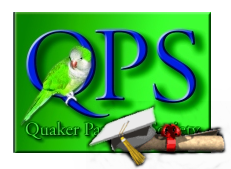QUICK PICK MENU
Information presented on the QPSerc pages is gathered from avian articles, books, reference materials, and the result of extensive discussion with Quaker owners, breeders, researchers, behaviorists, and avian veterinarians. It is not intended to replace the valuable information which your personal avian veterinarian shares with you.
Clean, chemical & pesticide free branches provide an inexpensive & natural "playground" for your birds.

SAFE AND TOXIC PLANT LISTING
Not all branches and plants are safe for birds. Some plants and trees may produce toxic or allergic reactions in avian species. This compiled listing of safe and toxic plants is only what is currently believed to be safe or toxic for our birds. It is always suggested to check with your avian veterinarian if you question the safety or toxicity of a particular particular plant, tree, or foliage.
No plant, tree, or foliage is safe if it has been sprayed with pestisides, toxic chemicals, or insecticides. Before using, inspect for insects and parasites, scrub all branches with a disinfectant, (such as diluted chlorine bleach), then rinse thoroughly, and dry well.